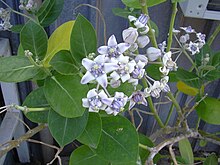Calotropis
| Calotropis (Milkweed) | |
|---|---|

| |
| Calotropis gigantea | |
| Scientific classification | |
| Kingdom: | |
| (unranked): | |
| (unranked): | |
| (unranked): | |
| Order: | |
| Family: | |
| Subfamily: | |
| Genus: | Calotropis |
| Species | |
|
Calotropis gigantea - ak/akund | |
Calotropis is a genus of plants that produce milky sap hence also commonly called milkweed. It is considered a common weed in some parts of the world. The flowers are fragrant and are often used in making 'floral tassels' in some mainland Southeast Asian cultures. Fibers of these plants are called mudar or mader. The plant is known as aak in Ayurveda. The latex is said to have a mercury-like effects on the human body, and is some times referred to as vegetable mercury and is used in place of mercury in aphrodisiacs.[citation needed] It is used variously but sometimes leaves are fried in oil for medicinal purposes.
Root bark has Digitalis like effect on the heart, but was earlier used as a substitute of ipecacuanha.
It is a poisonous plant; calotropin, a compound in the latex, is more toxic than strychnine. Calotropin is similar in structure to two cardiac glycosides which are responsible for the cytotoxicity of Apocynum cannabinum L. Extracts of flower of Calotropis procera has shown a strong cytotoxic activity in the patients of colorectal cancer. They are harmful to the eyes.
References
- Puri, H. S. (2003) RASAYANA: Ayurvedic Herbs for Longevity and Rejuvenation. Taylor & Francis, London.
- S. Morris Kupchan, John R. Knox, John E. Kelsey, and J. A. Saenz Renauld: Calotropin, a Cytotoxic Principle Isolated from Asclepias curassavica L. Science 25 December 1964.
External links
